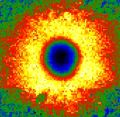Speaker
Description
The electronic characteristics of graphene undergo significant alterations depending on the structure and dimensions of its layers. Furthermore, in applications involving graphene, the manipulation of electronic states can be achieved through interactions with adsorbed species and by introducing atoms and molecules between graphene and the substrate, forming what is known as the van der Waals gap. Understanding the mechanisms underlying intercalation or adsorption is pivotal. In-situ microscopy provides a practical avenue for scrutinizing these processes, allowing real-time observation and analysis of dynamics as various species etch graphene stacks [1].
This study contributes a systematic examination of the interaction between oxygen and hydrogen molecules (isothermal etching) and the underlying graphene layer(s). It sheds light on the strength of interaction at both the graphene-graphene and graphene-substrate interfaces. Initially, a graphene layer was synthesized on a Pt wire at elevated temperatures using ethylene (C2H4) gas as a precursor within an ultrahigh vacuum (UHV) scanning electron microscope (SEM) chamber. To produce multilayer graphene in an inverted-wedding-cake configuration, the sample underwent cooling to varying temperatures (900 °C, 950 °C, and 1000 °C) after the first layer formation. This process led to carbon segregation from the Pt substrate and the formation of multilayer graphene islands under the first layer. Subsequently, the samples were exposed to O2 or H2 (similar to [2]) or CO to monitor the etching behaviour of both the first layer and the underlying layers. The growth and etching of graphene layers were captured in a series of movies, courtesy of SEM observations during the experiment. The data acquired reveal intricate details of the intercalation process, facilitating the quantification of vital parameters such as diffusion length and activation energy associated with the relevant processes.

